A-Maze-ing Challenges
(FOCUS: Grades 1 and 2, STEM, Math, Executive Function, Next Generation Science Standards)
Download a Printable PDF Lesson Here
Introduction: PCM’s exhibit “Mystery Mazes” is the inspiration for this lesson. “Mystery Mazes” challenges visitors to use their sense of touch and sound to navigate different mazes. Different mazes are sandwiched between two boards, and visitors must match mazes to maps. It is a good challenge and guests often cheer when they have figured it out!
In this lesson, students build a WATER DROP MAZE using no-cost materials and challenge peers, parents and teachers to make it to the end without their drop of water falling off or falling in. Mazes support the development of spatial thinking, important to understanding math and rely on trial and error and executive function to test and then remember which paths do NOT lead to the exit. And this particular maze also allows for experimenting with water and friction resistance.
Materials to gather
- Cardboard or cereal box
- Scissors
- ZIPLOC® or any clear plastic sandwich size bag that can be zippered or folded over the top
- Markers, crayons or pens and pencils
Student’s Job
Create a Water Drop Maze
- Cut a piece of the cereal box or cardboard into a shape that will fit inside the clear plastic bag.
- Before putting the cardboard into the bag, draw a maze onto a blank side of cardboard.
- Include the word start or a symbol that tells the person using the maze where to begin. And write the word end or make an X mark to know when it is finished.
- You may want to draw obstacles like turns, tunnels and dead ends to make your maze truly challenging! Make a small hole in the bag to create an absorption trap.
- Place your maze in the bag and close the top. Add one drop of water at the starting point and try to wiggle your drop from the start to the end without letting it drop off the bag.
- How does the size of the water drop effect your ability to make it from start to end?
- Explore how to change the friction resistance of the bag to slow down or speed up the drop’s journey.
- Make several mazes that can easily switch in and out of the plastic bag. Build better mazes using what you have learned and by taking inspiration from other students’ work.
Teacher’s Job
Align this lesson to the standards.
- PCM staff have connected this activity to Next Generation Science Standards. Students who demonstrate understanding can:
- 2-PS1-1: Plan and conduct an investigation to describe and classify different kinds of materials by their observable properties.
- 2-PS1-2: Analyze data obtained from testing different materials to determine which materials have the properties that are best suited for an intended purpose.
- Develop charts and opportunities to analyze data:
- Record the size of drop and make a comparison to another object- as big as a pinky nail or as small as a grain salt.
- Who finished the maze the fastest or the slowest?
- Comparing two strategies to determine which is most effective for controlling the drop? Is it tapping or tilting strategy.
- And collect data to inform the next version- is it too easy or too hard and where on the maze do people consistently lose.
- Prepare and Extend:
- Share pictures and read stories that provide examples of mazes. In New England some children have been inside a corn maze.
- Warm up or extend this activity by encouraging students to create a LEGO® maze that a marble can run through. And create a maze with masking tape on the floor or chalk on the sidewalk. Have students put on a blindfold and use words to guide them through the maze. Can they do it backwards?


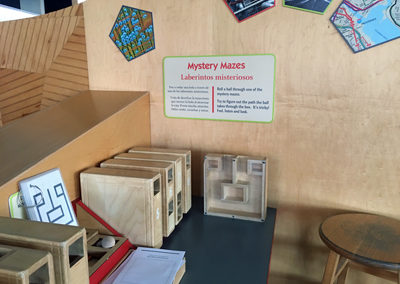
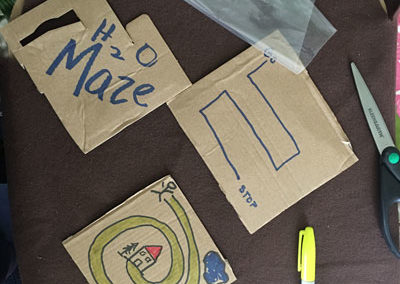
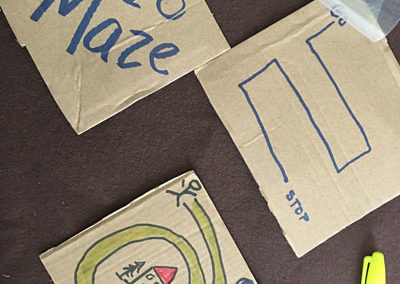
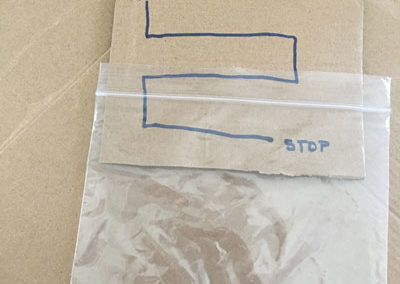
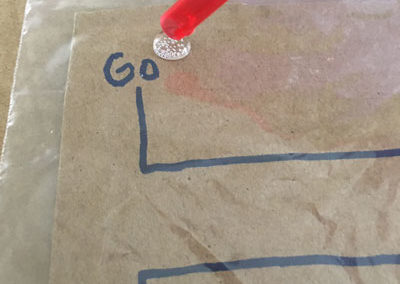
0 Comments